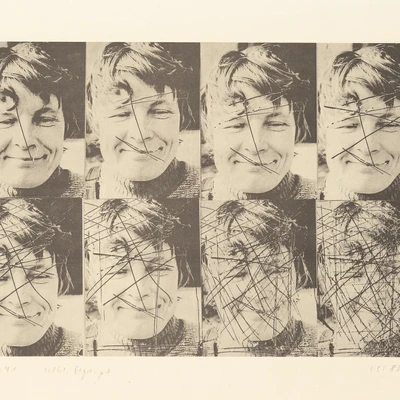Max Uhlig
- * 1937
Life dates
- Artist
Category
Fetishist of the Expressive Line with a Contempt for the Party Line
Born to a forest ranger in Dresden, Max Uhlig started drawing during his father’s furlough in 1943. For lack of any other material, the six-year-old worked through his experience of the war with a red-and-black pencil. He thus set, at so early an age, the groundwork for his later art, heavily based on lines, hovering between abstraction and realism, and in many ways recalling Jackson Pollock.
So that he would not "have to go to the politically harnessed painters, who were painting in the new socialist-national fashion of a committee for domestic peace,"[1] Uhlig studied abstract drawing from 1955 to 1960 at the HfBK Dresden and then completed his masters with Hans Theo Richter between 1961 and 1963 at the German Akademie der Künste in East Berlin. From Richter, he adopted the principle of geistiges Zeichnen (intelligent drawing). When the rest of his family emigrated to West Germany in 1960, Uhlig decided to remain in the Socialist Republic, and embarked on a path as free-lance artist that stands unique in the artistic legacy of the GDR. Painting directly from nature on the Baltic Sea or in the Uckermark, Uhlig became one of the last protagonists of plein-air painting and produced his first drawings with a modern-expressionist character – work which earned him little but scorn. To earn a living, Max Uhlig then opened a graphic arts workshop in Dresden and became one of the GDR’s most well-known art printers. He quickly gained international recognition through his lithographs and etchings for famous and exceptional figures such as Carlfriedrich Claus and Gerhard Altenbourg. When he attended the graphic art biennales in Cracow and London, collectors and professionals recognized the quality of his work, clearly oriented towards the international contemporary art scene, and began to buy it. Although his portraits and landscapes composed of a dense mesh of lines correspond to anything but the official art doctrine of the GDR, tethered as it was to "realism," Uhlig was tolerated by the East German state and its various art institutions. His international reputation, growing through representation by galleries in Stuttgart and Ravensburg, was exploited as a source of foreign currency.
In stark contrast to colleagues who emigrated to the West, such as A.R. Penck or Georg Baselitz, Uhlig never styled himself as an artist-rebel. He asserted individuality and opposition in his own way through a calm and steady working rhythm from his home in Saxony. Unlike many other like-minded artists, Uhlig was rewarded for this stance and his work following the fall of the Wall: in 1989, the father of three children obtained a guest professorship in Nürnberg, two years later another in Hamburg. Between 1995 and 2002, he was engaged as full professor of painting and the graphic arts at the Hochschule für Bildende Kunst in Dresden – a position long deserved but which would have been unthinkable in the GDR. Thus he was able to shape another generation of young artists. In 1999, German Chancellor Gerhard Schröder even commissioned a portrait from Uhlig. For his engagement as an artist, characterized by a sense of community and quiet activism, he was awarded the Bundesverdienstkreuz (Federal Cross of Merit) in 2022.
Despite the physical constraints of age and his granting of a comprehensive legacy trust to the Saxonian Kulturstiftung, the passionate painter continues to work in his Dresden atelier, even as it is converted into an international artist residence. For his most recent commission, Uhlig produced 14 stained-glass Gothic windows for the Johanniskirche in Magdeburg.
text: Sylvie Kürsten, translation: Darrell Wilkins
[1] Max Uhlig in an interview at the SKD on 7 February 2019 https://www.youtube.com/watch?v=MF9JLaVLmGM&themeRefresh=1
Works by Max Uhlig
Travelling exhibition
Publik machen: 40 Künstler:innen aus dem Bestand des Zentrums für Kunstausstellungen der DDR
Popular keywords
Many more works are hidden behind these terms
